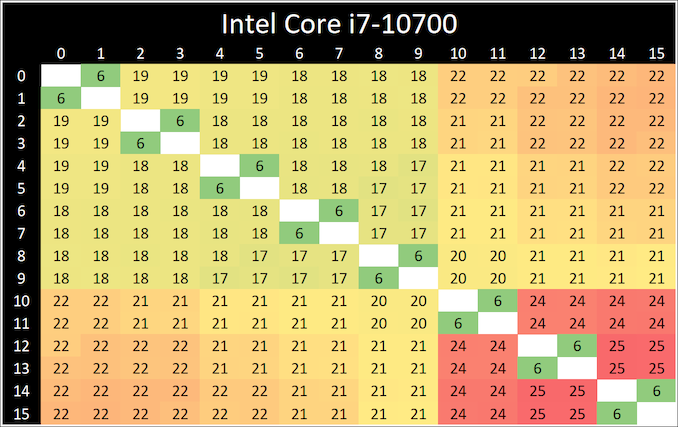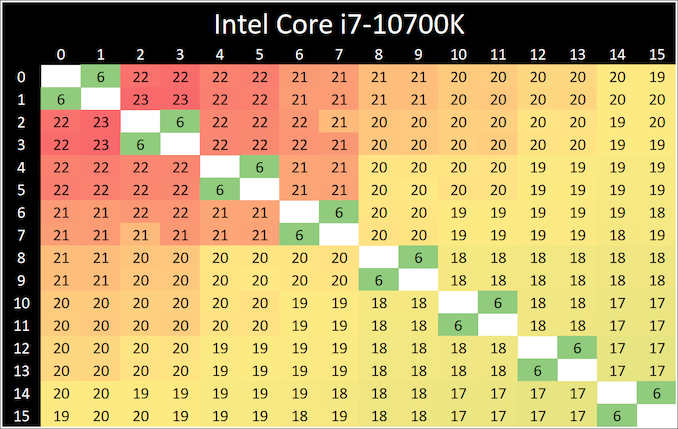Intel Core i7-10700 vs Core i7-10700K Review: Is 65W Comet Lake an Option?
by Dr. Ian Cutress on January 21, 2021 10:30 AM EST- Posted in
- CPUs
- Intel
- Core i7
- Z490
- 10th Gen Core
- Comet Lake
- i7-10700K
- i7-10700
CPU Tests: Microbenchmarks
Core-to-Core Latency
As the core count of modern CPUs is growing, we are reaching a time when the time to access each core from a different core is no longer a constant. Even before the advent of heterogeneous SoC designs, processors built on large rings or meshes can have different latencies to access the nearest core compared to the furthest core. This rings true especially in multi-socket server environments.
But modern CPUs, even desktop and consumer CPUs, can have variable access latency to get to another core. For example, in the first generation Threadripper CPUs, we had four chips on the package, each with 8 threads, and each with a different core-to-core latency depending on if it was on-die or off-die. This gets more complex with products like Lakefield, which has two different communication buses depending on which core is talking to which.
If you are a regular reader of AnandTech’s CPU reviews, you will recognize our Core-to-Core latency test. It’s a great way to show exactly how groups of cores are laid out on the silicon. This is a custom in-house test built by Andrei, and we know there are competing tests out there, but we feel ours is the most accurate to how quick an access between two cores can happen.
When we first reviewed the 10-core Comet Lake processors, we noticed that a core (or two) seemed to take slightly longer to ping/pong than the others. These two parts are both derived from the 10-core silicon but with two cores disabled, and we still see a pattern of some cores having additional latency. The ring on the 8-core parts still acts like a 10-core ring, but it all depends on which cores were disabled.
Frequency Ramping
Both AMD and Intel over the past few years have introduced features to their processors that speed up the time from when a CPU moves from idle into a high powered state. The effect of this means that users can get peak performance quicker, but the biggest knock-on effect for this is with battery life in mobile devices, especially if a system can turbo up quick and turbo down quick, ensuring that it stays in the lowest and most efficient power state for as long as possible.
Intel’s technology is called SpeedShift, although SpeedShift was not enabled until Skylake.
One of the issues though with this technology is that sometimes the adjustments in frequency can be so fast, software cannot detect them. If the frequency is changing on the order of microseconds, but your software is only probing frequency in milliseconds (or seconds), then quick changes will be missed. Not only that, as an observer probing the frequency, you could be affecting the actual turbo performance. When the CPU is changing frequency, it essentially has to pause all compute while it aligns the frequency rate of the whole core.
We wrote an extensive review analysis piece on this, called ‘Reaching for Turbo: Aligning Perception with AMD’s Frequency Metrics’, due to an issue where users were not observing the peak turbo speeds for AMD’s processors.
We got around the issue by making the frequency probing the workload causing the turbo. The software is able to detect frequency adjustments on a microsecond scale, so we can see how well a system can get to those boost frequencies. Our Frequency Ramp tool has already been in use in a number of reviews.
Both processors ramp from idle to full turbo in about six milliseconds, well within a single frame of standard gaming.













210 Comments
View All Comments
bji - Thursday, January 21, 2021 - link
To clarify: 95% was an exaggeration. Micro Center has like 20 or 30 stores and is accessible by more than 5% of the USA population. But it's probably not more than 20%. Anyway any store that is not available to the majority of people cannot be called "general availability".bji - Thursday, January 21, 2021 - link
I mean seriously. If Micro Center were that easy to get through, would there even be a shortage of these chips at online vendors? Everyone would already be satisfied by the Micro Center supply. But a) the fact that there is online shortage means very clearly that most people can't get one from Micro Center (otherwise they already would have and there would not be zero supply online), and b) if a significant fraction of the population could actually get them from Micro Center, Micro Center would clearly already be sold out also.magreen - Friday, January 22, 2021 - link
@bji: How do you feel about Microcenter?calc76 - Friday, January 22, 2021 - link
I'd suspect its probably well more than 50% of the US population is within an hour drive of a Microcenter. The names of the cities listed on their site aren't all easily recognizable but the metro areas are almost all the large ones.Atlanta
Baltimore
Boston
Chicago
Cincinnati
Cleveland
Columbus
DC
Detroit
Denver
DFW
Houston
Kansas City
LA
Minneapolis
Newark
NYC
Philadelphia
St Louis
Dug - Friday, January 22, 2021 - link
They were actually available today at Amazon for a very long time at @299. Of course it's back up again after mass ordering at the time I'm posting this.bji - Friday, January 22, 2021 - link
I checked several times today. How did I miss that? I doubt it was for a very long time. Probably closer to that 10 minutes I mentioned.jimbo2779 - Friday, January 22, 2021 - link
Nephew bought a 5600x for MSRP here in the UK from Currys which is by far the largest national chain of electronics and computer equipment.You could try signing up for an alerts service, providing you have the funds ready to put down you could likely have one in the next week or so. Not as ideal as next day from any major retailer but the chips are coming in stock.
Spunjji - Friday, January 22, 2021 - link
UK here. They do mention low availability of that chip in the article, but I notice that didn't prevent you coming here to whinge about it anyway.From my perspective in the UK, they have 10+ in stock at Overclockers for £299.99 and unspecified stock at CCL for £309.
I must say I especially enjoyed how you elaborately set up the goalposts in your first post, then moved them around with every response. Good game!
bji - Saturday, January 23, 2021 - link
No goalposts were moved. If you'd care to elaborate, I'd respond. Or were you just whining about my whinging?Spunjji - Monday, January 25, 2021 - link
That last bit. 👍Your original post said that none of the processors have had general availability and that it would be months before prices hit MSRP. People have pointed out a few times that in various parts of the world, availability is there and prices are at (or very near) MSRP, yet you've still found reasons not to admit that maybe you overstated things a bit.